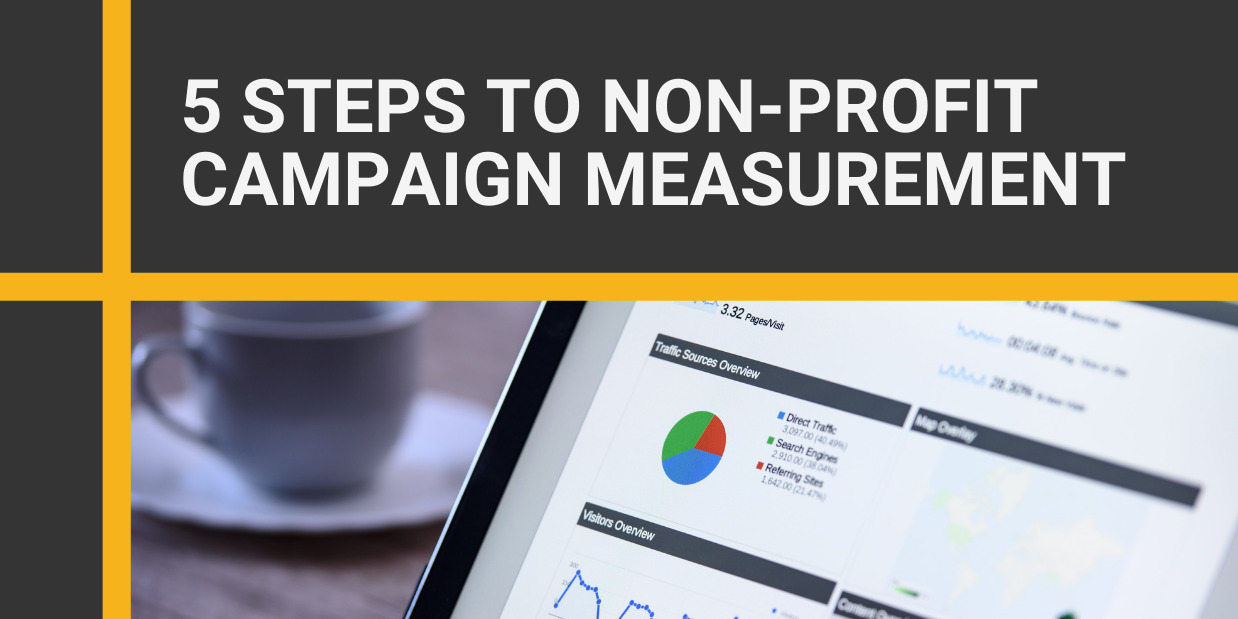With the future so uncertain, data can be a crystal ball for marketers in today’s world. Effectively creating measurable objectives and accurately tracking your progress towards those objectives is your best guarantee of success. But if you’re wondering how to measure non-profit campaigns and cause-oriented marketing initiatives outside of donations, you’re not alone.
Here are five steps to help you create measurable communications objectives, identify the right set of non-profit marketing KPIs for your organization, define and align marketing metrics internally, and measure your non-profit marketing campaign work in meaningful terms.

Katie Paine, CEO and Publisher of Paine Publishing
Step 1: Use Organizational Goals to Create Measurable Communications Objectives
In the non-profit world, an organization’s mission is usually to achieve some kind of social impact, such as saving lives, preserving natural habitats, supporting arts events, or changing government policy. You can probably articulate your organization’s mission and key messages by heart, but do you know and understand the business plan that will make the mission happen? Creating measurable communications objectives is key to identifying your non-profit’s marketing KPIs.
Your first step is to make sure you have a consensus around the goals and objectives for your efforts. Typically, there are two kinds of objectives. First, there are the organizational objectives: the priorities that the organization has established as necessary to achieve its mission (i.e., raise money, expand the donor base, or help solve a problem). These are priorities that everyone in the organization is working towards.
Then there are the communications objectives, which is how you help achieve those priorities. Typical communication objectives might be to disseminate key messages, increase engagement or gather support for an initiative.
Always start with SMART objectives (Specific, Measurable, Achievable, Relevant, and Time-Bound). Once you create your measurable communications objectives, make sure you have a consensus between your team and leadership about how your activities connect to the organizational priorities. It would help if you decided which activities to track and to what end in order to determine the right set of communications KPIs.
Step 2: Identify Which Non-Profit Marketing Metrics Measure Your Campaign
Once you create measurable communications objectives, the second step to non-profit campaign measurement is to connect the dots between the communications activities and the organizational priorities, especially since there is seldom a straight line between the two. For example, an Instagram post by an influencer can’t eradicate polio, but it can raise money for the cause or change someone’s mind about the issue.
You and your team also need to get agreement and consensus with leadership on the path from a marketing communications tactic (i.e., a social post, a press release, or an event) to the ultimate goal, be it to raise money or increase support. From there, you can determine which non-profit marketing metrics will help you gauge the effectiveness of each tactic toward the objective it was designed to achieve. A typical path might look like this:
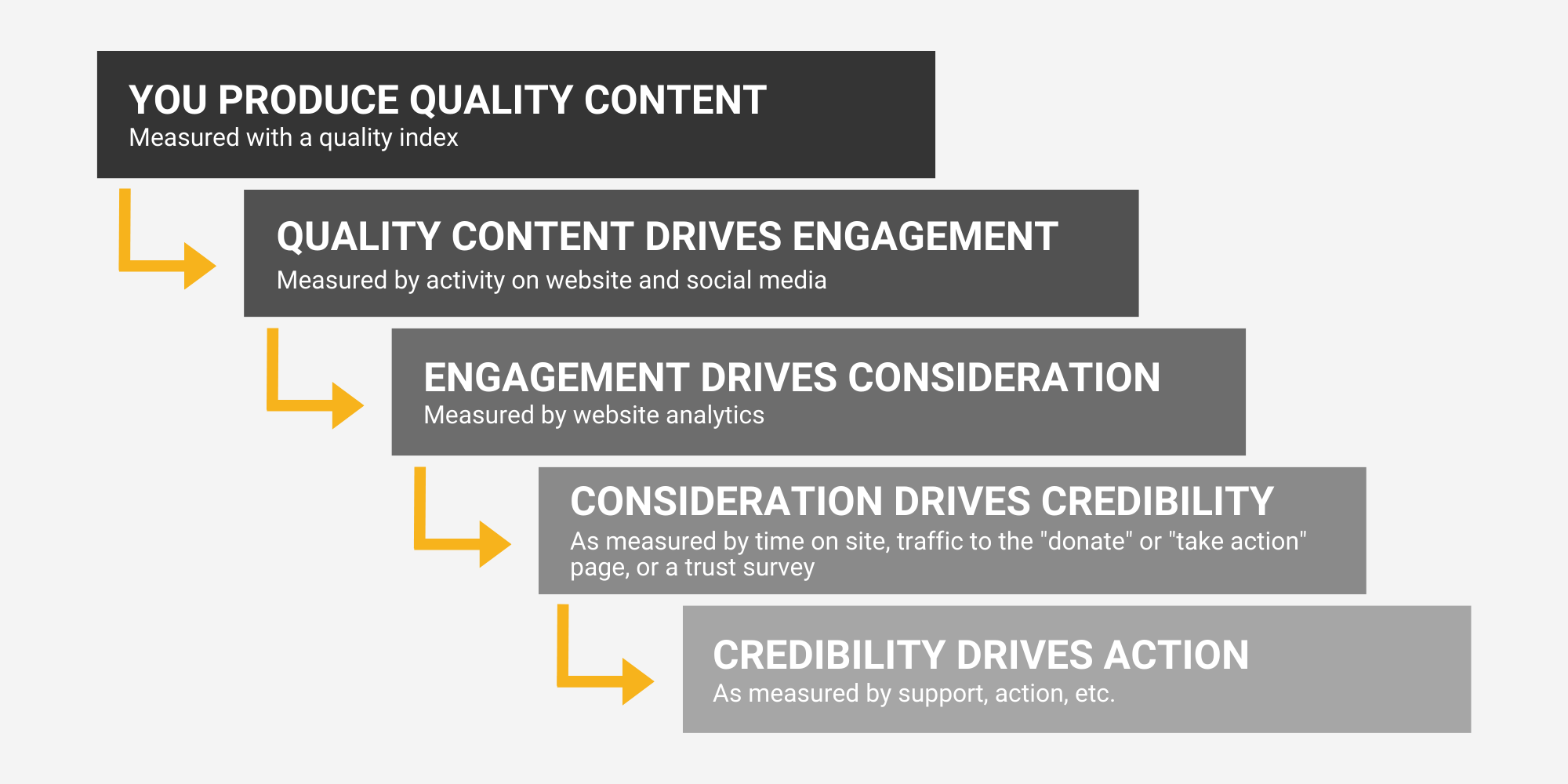
Click here to download all the charts featured in this blog.
Once you’re internally aligned on your path, you’ll need to get even more specific in setting your marketing metrics. For context and to give you a frame of reference, the below chart outlines typical non-profit goals and the metrics to measure them:
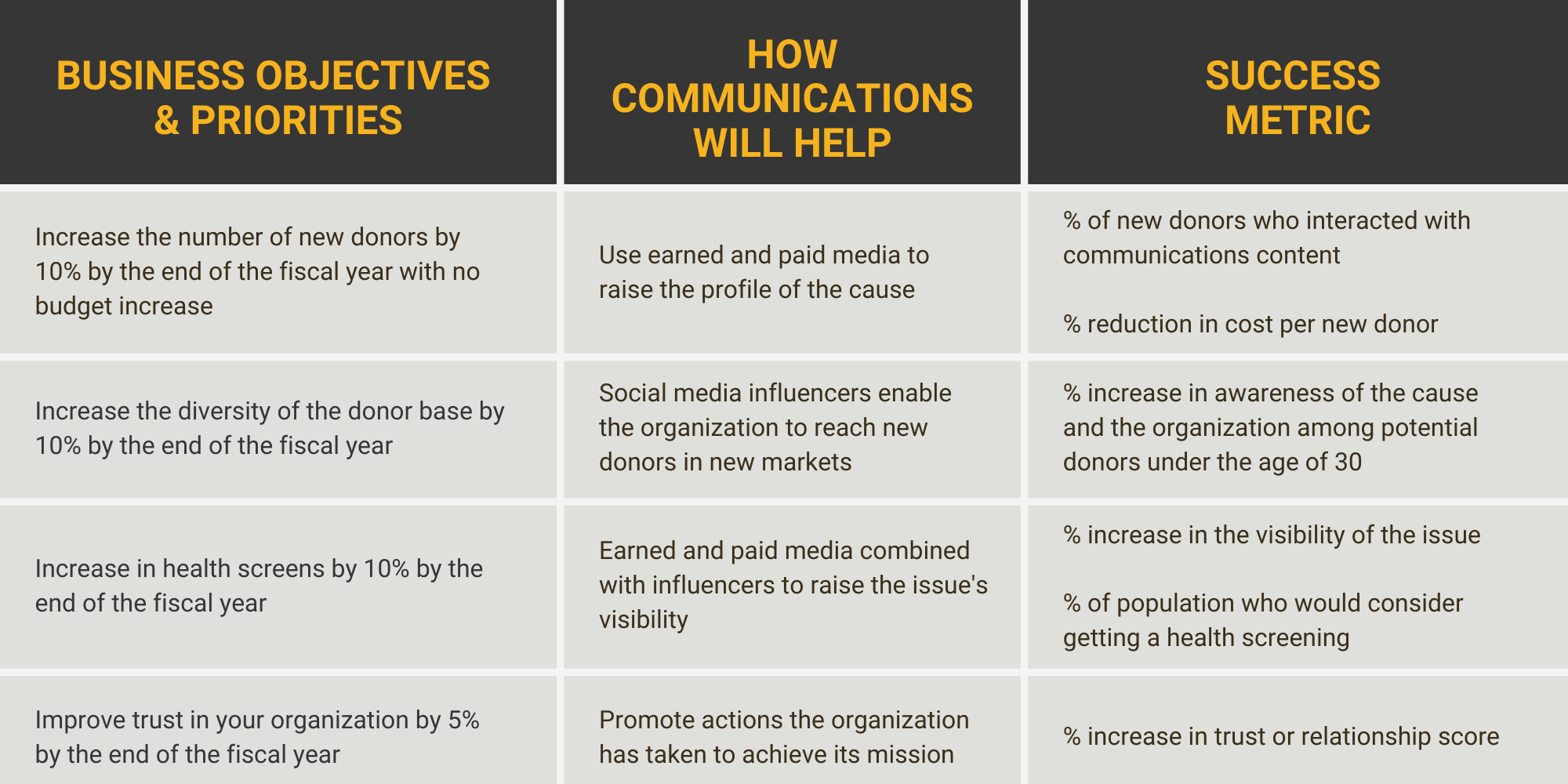
Click here to download all the charts featured in this blog.
Step 3: Defining Non-Profit Marketing Metrics and Discovering the Data
The next step to campaign measurement is all about the data. The measurement challenge is tracking down the data you need for your non-profit marketing metrics and getting rid of all the data you don’t need. These are the communications KPIs that you already tied back to your measurable communications objectives and organizational goals in Step 2. Before you start collecting data, you need to know what data currently exists. So, check-in with your membership department, donor database, marketing, accounting, library, and anyone else who may have valuable data. As you look to establish baselines and draft data collection processes, find out whether any other departments have data that you can use to create your metrics and measure your non-profit campaign metrics.
Another key element at this step is to establish clear definitions for your non-profit marketing metrics. Get together with your team and get a consensus. You’d be surprised to learn that people define even the most commonplace communications KPIs and measurement terms differently. Depending on the metrics you’re evaluating, you might want to align on definitions for things like the following:
- What is in a “good” or “great” article?
- What is in a “nightmare” article or post?
- What does an engaged employee do differently from one who is not engaged?
- What does an engaged donor or volunteer do differently from one who is not engaged?
- How do you define “influential”?
Once you’ve decided on your communications KPIs and definitions, we recommend creating a “quality score,” a weighted index that can incorporate many different criteria into a single number, making it easier to report. A typical Quality Index for Earned Media Content might look like this:
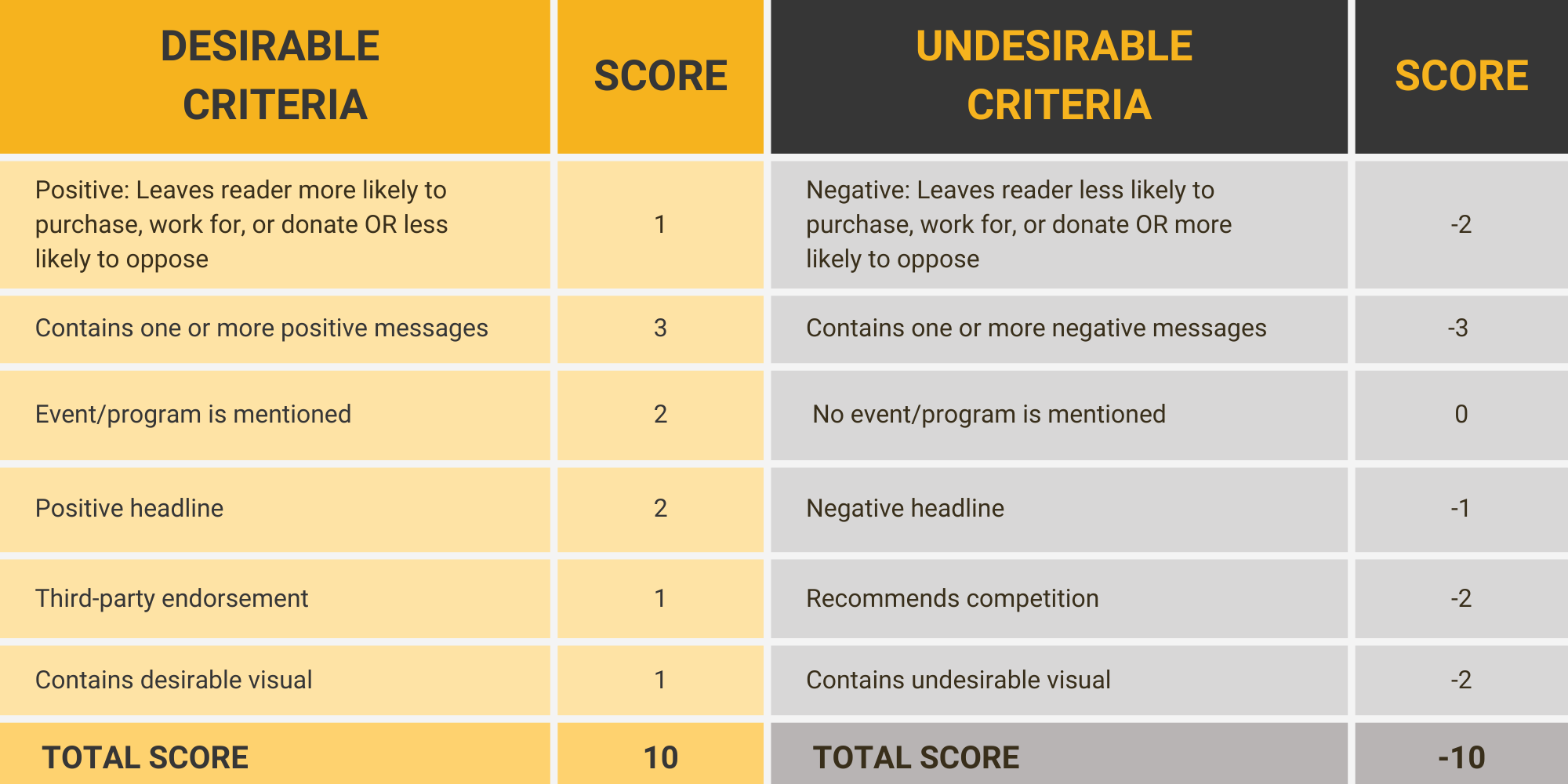
Click here to download all the charts featured in this blog.
Step 4: Determining Cost-Effectiveness
There’s one more decision you need to make. Measurement is, above all, a comparison tool. You can certainly compare your results today to the results from last quarter. If possible, you may want to identify a peer organization or a perceived competitor for share. Comparing yourself to another non-profit tends to get your boss’ and board’s attention. But the most important benchmark is how effective your program is compared to other tactics (i.e., direct mail, events, or sponsorships). Learning how to measure non-profit campaigns means knowing how to calculate cost-effectiveness metrics.
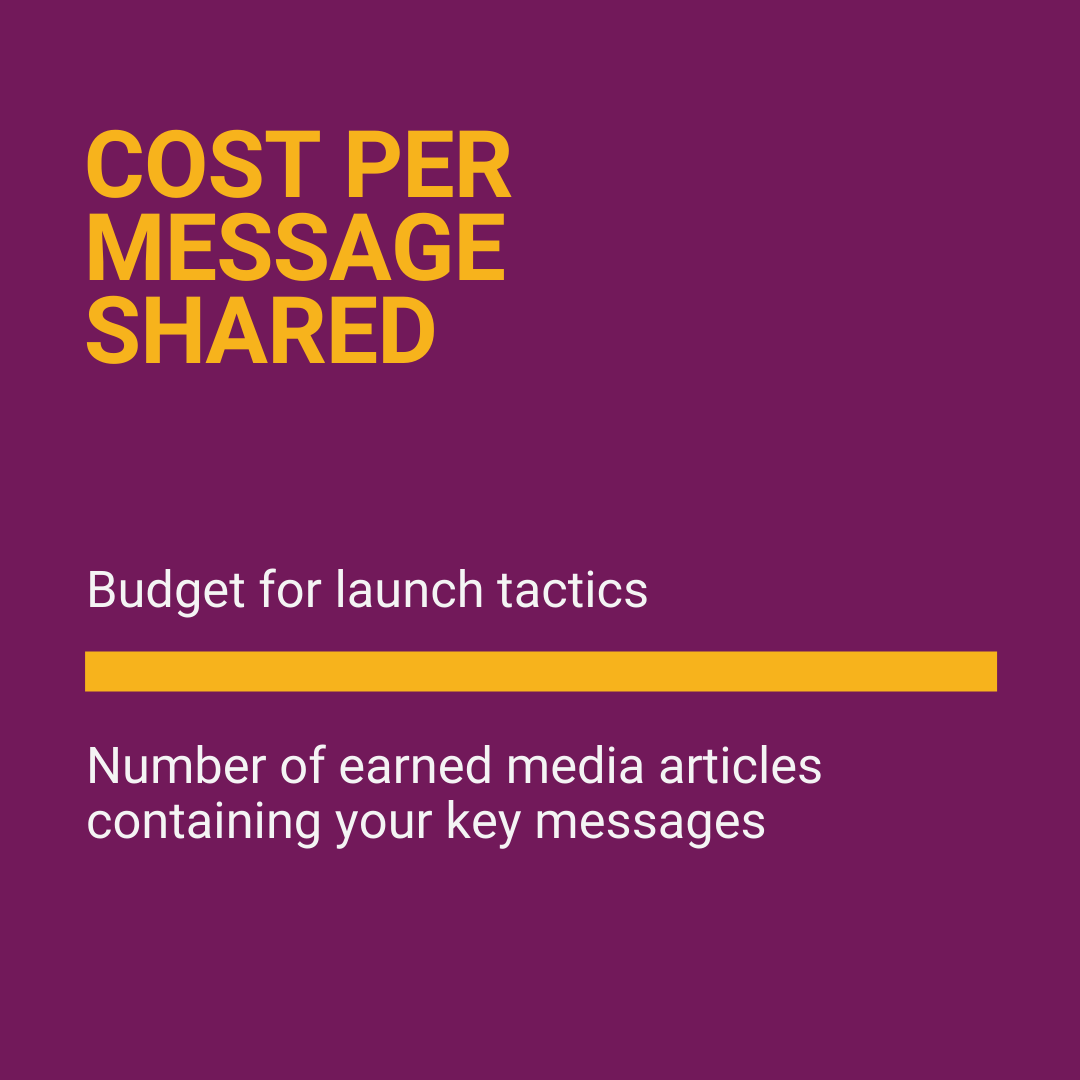
How to Measure Cost per Message Communicated
Cost per thousand (CPM) is a commonly used way of judging the efficiency of one media over another and has been used in advertising for years. There is no reason why earned media (i.e., public relations) can’t use it just as easily. Let’s assume that getting exposure for your key messages is the goal. To measure the effectiveness of one launch tactic over another, you take the budget for the two events and then compare the percentage of your coverage that contained a key message to calculate a cost per message communicated. If you have a lot of coverage, you may need to recruit a volunteer to read it all to identify the articles that contain your key messages.
Here’s an example: Back in my days at a software company, we were debating what would be the best strategy to launch a new initiative. The product manager wanted to do a major event, but the PR person wanted to do a press tour. Luckily, we had data that showed that the last major event cost $300,000 and was completely ineffective at getting the key messages across to the media and key influencers. The data also showed that a $15,000 press tour we conducted had successfully gotten key messages into top-tier media. The cost per key message communicated for the event was nearly twice the cost of sharing the same messages via a press tour. This data made the decision obvious and saved us from making a $300,000 mistake.
How to Measure Cost per Supporter Acquired
At your non-profit, count the number of new donors each month. Divide that number into the total amount (including salaries) of your budget spent trying to communicate with or otherwise acquire those donors. Compare the cost per donor acquired to last year or between tactics to acquire them. Or compare that cost to direct mail or an event.
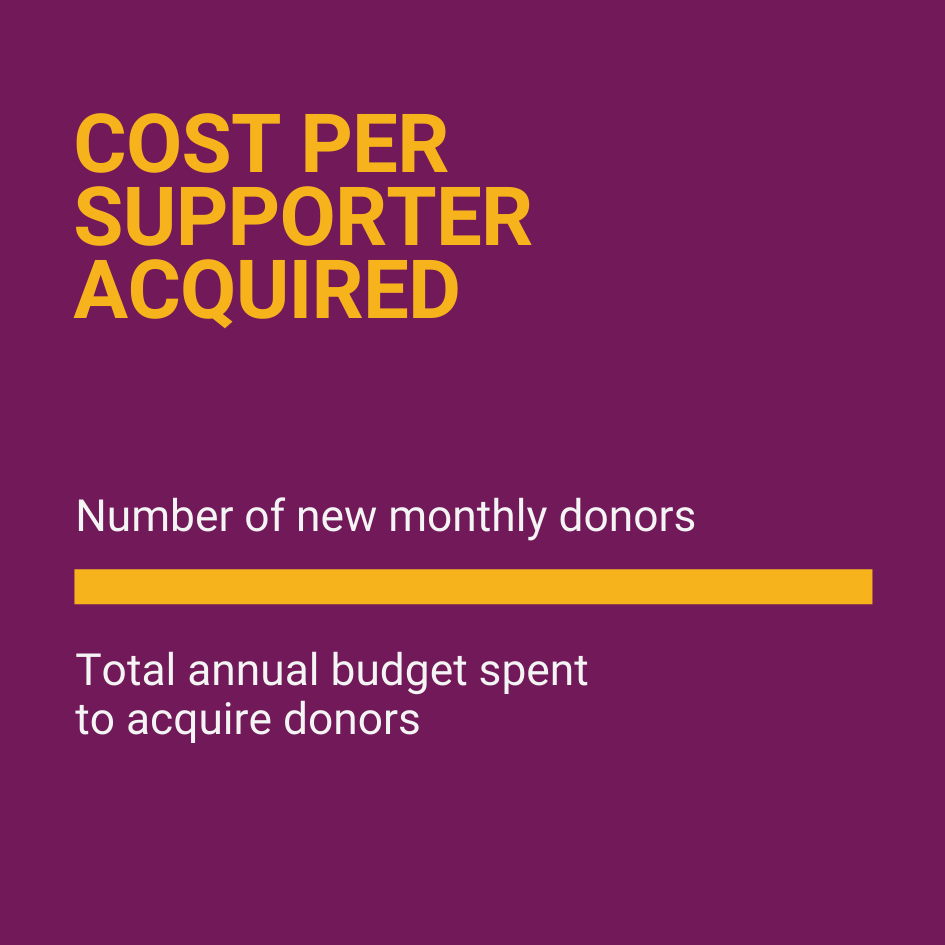
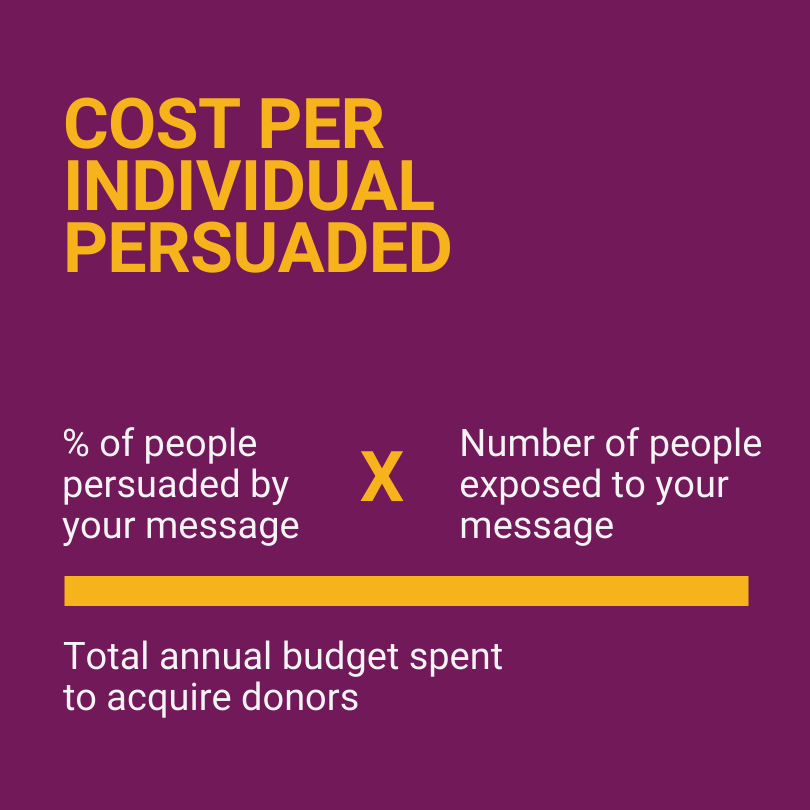
How to Measure Cost per Persuaded Individual
Many PR programs have “Raise awareness for a particular issue or message” as a goal. If that’s your goal, you need to know two things. First, did your audience see or hear the message? Second, did they believe it or not, and were any minds changed? You probably think doing pre-post awareness surveys is too expensive, right? Wrong.
Think creatively. Can you build a “test” into your next event to gauge people’s awareness? Give them a prize for getting three correct answers. Once you get answers, take the percentage of people aware of and/or persuaded by your message and multiply it by the number of people exposed to that message. Then take your budget and divide it by the result, and you’ll know the cost per supporter persuaded.
Step 5: Finding Insights
For most marketers, the interest in learning how to measure non-profit campaigns comes from a deeper desire to learn and improve continually. It’s a mindset. With that in mind, the final step you need to measure your non-profit campaign is analysis. Part of the measurement process is to analyze your data to discover your “aha” moment. Often, people conflate campaign reporting with campaign analysis. But these are different things. Tracking the right set of marketing metrics is important, but you’ve still got to analyze what the metrics are telling you so that you can grow.
When you’ve got all your campaign metrics and data points, start by looking at what performed the worst. The data is the data, and the most important thing you need to know is what isn’t working, so you don’t waste more time and money on whatever that is. Then look for anomalies and other numbers that surprise you. That’s where you’ll discover the hidden gems in the data. Decide what you can do better, what needs to be dropped or fixed, and you’ve got your insights.
This article was written by Katie Paine, CEO and Publisher of Paine Publishing. Originally published on Entertain Impact.

